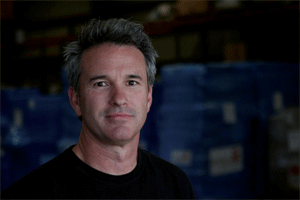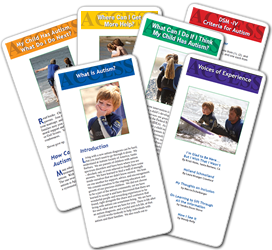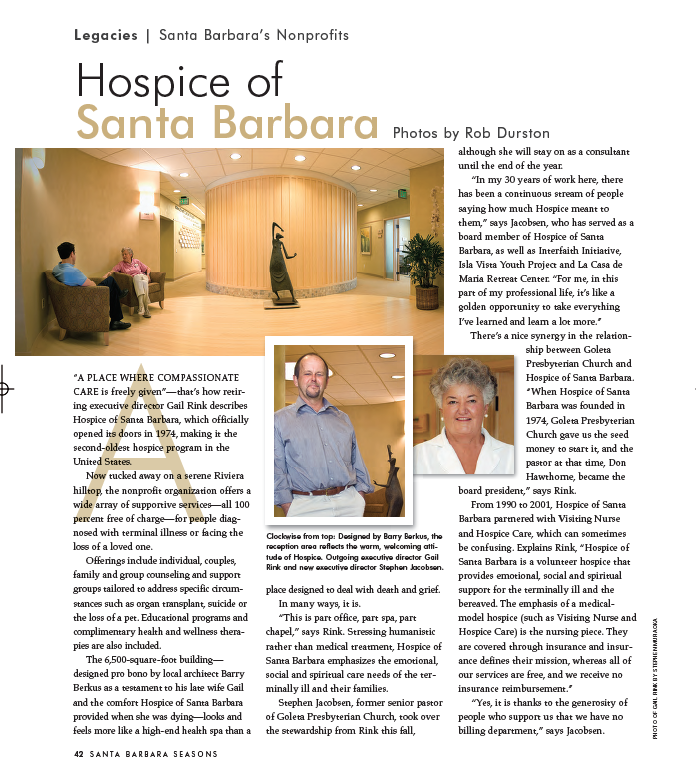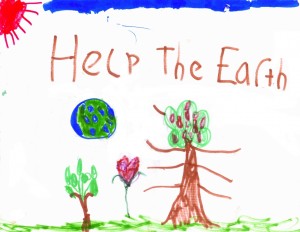Since Thomas Tighe arrived in Santa Barbara to head up Direct Relief International eight years ago, the nonprofit humanitarian medical organization has made cash grants of more than $30 million and furnished over $850 million of essential medicines, equipment, and supplies to support health services for low-income people in 88 developing countries and all 50 United States. Clearly, this is a guy who gets things done.
LD: How has Direct Relief changed since you first came to town?
TT: I hope it’s better. Really what I was hired to do was to take it to the proverbial next level–but don’t mess up what’s good about it. …With Direct Relief we’ve tried to stay true to our roots and be what we always were, but bring it forward and apply some new tools and some new energy to, sadly, the same issue. There’s still poverty that is chronic and deep and oppressive. …. The expansion to helping out much more extensively in the United States was something that was really modeled on what had been. We had always tried to fill the gaps here in Santa Barbara, but not get in the way of government or get in the way of business. It’s the same thing. Those gaps are all over the place, including our own country, so it’s been helpful to be able to do more without really fundamentally changing your sense of what the organization is all about.
LD: You’ve certainly been successful.
TT: I’m really sensitive to the fact that Direct Relief is 60 years old. I’m just the most recent person in my particular job but the organization is something that others have built and many have contributed enormously to. It’s always a little unseemly for me to receive disproportionate thanks for work that thousands of people have done. To give people on the board their due, there are 60 board meetings a year here. It’s an enormous commitment of time. Stan Hatch, our chairman, I’m sure he’s putting in over a thousand hours of his time. … The quality of the commitment is just huge and has been for a long time.
LD: Does the idea of global citizenship seem like it’s more in people’s consciousness now than it was eight years ago?
TT: I think so. There’s a general consciousness of world events that is probably actually worse in some regards, because you only hear about foreign countries when something really bad happens. The attention-grabbing events tend to be bad and it tends to actually foster fear about what is going on out there. But I think underneath that there is a recognition that the world is getting smaller. We’re getting so stitched together through forces of globalization in an economic sense that there are winners and losers and I think an appreciation for the underlying human common element has emerged today.
LD: Direct Relief is this incredibly successful, wide-reaching global organization, yet it is located in a warehouse in Goleta. Does it feel like this organization could be anywhere other than where it is?
TT: I don’t think if you were going to start it today you would start it here, because it is not in the hub of global health or pharmaceutical stuff. But I think one of the many good things about being here is it is an intersection of all sorts of interesting people who either live here now or live here part-time who have an incredible depth of experience and insight into things in the world. There is no company in the United States that wouldn’t want to have our board of directors. These folks have really achieved remarkable success in their professional lives in all sorts of different walks of life. So Santa Barbara is the common element. Having that type of talent in such a small place is extraordinary and we’ve really benefited from the location.
And it’s a great place to have meetings because people will come to them. (Laughs)
LD: Did you always want to do humanitarian work?
TT: I really wanted to be major league baseball player, but I was not even close to being good enough to being a major college player. It was not a well-planned career path that I pursued, but it was much more a series of composite events that have led me to be doing what I’m doing now. First and foremost was probably just joining the Peace Corps after law school, which was a really bad career move. I finished law school and I passed the bar and then went to Thailand for a few years. … Then going back to Washington I was lucky enough to go from being a Peace Corps volunteer to a lawyer on a senate committee that dealt with the Peace Corps’ oversight. … I was lucky to have a series of jobs I really liked, found interesting and led to something else that I really like and found interesting and they’ve led me here– which I love and find really interesting.
… My best advice I give people is to write for their college daily newspaper. It’s the best training. … Really almost any job, any policy job, you need to communicate well in writing. There’s a discipline and a skilled kind of thought process that you have to go through before you can put the words down. You actually have to get it before you can write it.
LD: That’s funny because a few of my interns over the years have joined the Peace Corps.
TT: It’s great training … just think how many times (as a writer) you’re assigned to something and you have no idea about it, but you knew how to find out, and then you had to convey to people who were like you the day before and hadn’t heard about it and you had to get it right and you had to make it accessible without dumbing it down so much that it became devoid of meaning and that’s really a critical skill.
LD: I guess no matter what business you’re in; you’ve got to tell your story.
TT: You’ve got to make it accessible and without making it overly emotional or maudlin or anything. You’ve got to really do justice to the people we’re trying to help out because they’re great people, they’re not objects that should be pitied, they are just people who found themselves in a lousy situation. And the staff does it really well.
LD: Are you on the road very much?
TT: Maybe about 20 percent of the time … It’s a mixture of international travel, which is increasingly not as important because of the other folks in our organization are totally capable of representing the organization at any level of sophistication. … A lot of it is just talking to folks in companies or different organizations that might be interested in working with us or helping us out or figuring out a way that we can work together.
LD: Is it primarily people in the healthcare field or are there others that could potentially help out?
TT: It’s both. The healthcare companies have been great to Direct Relief for decades. Some of the companies that have really engaged with us in the past few years in an expansive way have been Google and Fed Ex. … I think we were one of the first nonprofit organizations that Google gave basically free advertising to on the Internet. So it’s allowed millions of people to find us that wouldn’t have found us because Google gave us an ad words campaign, and people find most of their information online.
Then Fed Ex has allowed us to get this incredible expansion to help out nonprofit clinics around the country, like we’d always tried to do with the Santa Barbara Neighborhood Clinic, fill gaps that arise in their program with resources that we could get donated. … So we’ve been able to expand that program now to all 50 states, it’s an over $100 million program run by Damon Taugher here on our staff. Fed Ex has delivered every shipment that we’ve sent domestically, free of charge, for the past three years. That’s been a few thousand individual shipments containing over four million full courses of prescription medicines for patients. Our costs of running that program are really low because Fed Ex has given us this incredible transportation subsidy.
So if we can find companies who are doing part of what we are trying to do and we can talk to them about doing it as an in-kind contribution, it sure keeps the need to raise money down. You know, we always need money to do something else with, but we don’t always need money to raise money to buy a good or a service.
LD: What you like to do when you’re not working?
TT: We have four kids, so spending time with my wife and four kids doing beach stuff or usually outdoor stuff. We like to spend time together and that’s such a treat in life to be able to spend time and particularly around here, there’s so much to do.
LD: If you could pick three adjectives to describe yourself, what would they be?
TT: Hopeful, graying rapidly and enthused.
Vital Stats: Thomas Tighe
Born: August 21 in Waukesha, Wisconsin
Family: Wife Carrie, and children Travis (14), Andrew (12), Griffin (10) and Megan (7).
Civic Involvement: Montecito Union School, Santa Barbara Middle School, Visiting Faculty Member at UCSB’s Masters Degree program in Global and International Studies.
Professional Accomplishments: Peace Corps Volunteer; Lawyer in the U.S. Senate, worked with Foreign Relations and Veterans Affairs Committees; Chief Operating Officer and Chief of Staff for the Peace Corps; President and Chief Executive Officer of Direct Relief International
Little-Known Fact: “I was a novice Buddhist Monk when I was in the Peace Corps for a very short time, for about a week.”
Originally published on Noozhawk on April 28, 2008.




 “A PLACE WHERE COMPASSIONATE CARE is freely given”—that’s how retiring executive director
“A PLACE WHERE COMPASSIONATE CARE is freely given”—that’s how retiring executive director 
